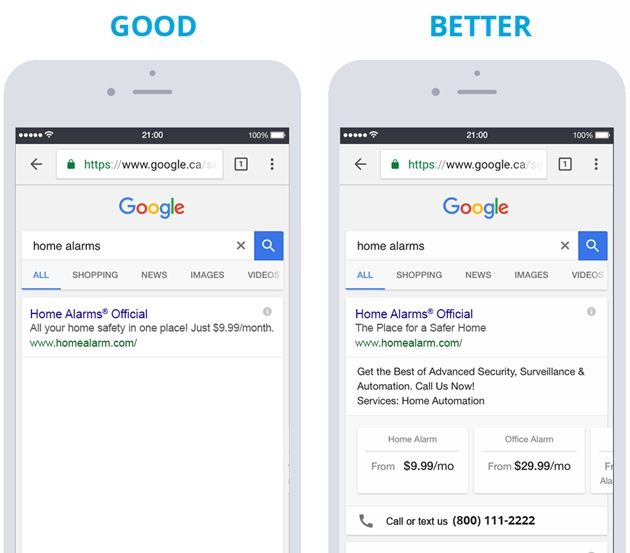Getting ready for a mobile-first 2017, Google announced four changes to AdWords that will improve ad performance if you use the right tools and tactics to maximize response.
All the changes are intended to open up new channels for marketers on mobile devices and give more choices to consumers.
Let's look at four easy tweaks, using the tools you already have, to make the most of those new channels to get more leads and improve your conversion rate.
1. Increase conversions by up to 80% with Message Extensions
October 2016: Message Extensions. In fall 2016, Google rolled out click-to-message for ads displayed on mobile to boost engagement in the channel consumers prefer most. The beta users saw remarkable results: an 80% boost in conversion rates compared with a similar channel and with the same ad creative. For any company looking to drive more leads, implementing click-to-message clearly promises low-hanging fruit, offering more leads for minimal up-front investment.
Designed with local business owners in mind, Google's basic click-to-message works best for those who expect a manageable volume of texts from a localized and targeted campaign. The advertiser uses a single textable phone line in the message extension at the bottom of the ad, and all incoming texts go to that one line. If someone isn't attending the phone line, resulting in no response or a delayed response, that opportunity will be lost and the consumer will likely be upset and move on to the next, responsive business.
For all sizes of companies expecting a large volume, basic click-to-message makes sense only with a third-party chat software to handle the flow of incoming texts with the instantaneous response expected by consumers.
A third-party chat solution eliminates the chance of lost leads, and it scales the AdWords enhancement by sending texts to your frontline sales team or contact center, already set up to handle a large volume of incoming inquiries.
A text-enabled call tracking number is used for the message extension, and all the incoming texts are sent to a chat platform such as LiveChat, ContactAtOnce!, or Slack, and can be viewed on any device.
Chat platform integrations with response analytics allow incoming texts to be handled efficiently with the software already in place, and can transfer conversations between sales to connect the consumer with right information quickly. The agent's responses will pop up in the consumer's native texting app but they'd be handled by the chat software on the business side (read more here to find out about integrations with popular chat software and analytics).

2. Optimize messaging to improve the quality of leads with Expanded Text Ads
January 31, 2017: Expanded Text Ads Replace Standard Ads. As of early 2017, marketers are no longer able to create new standard text ads for display and search, but this isn't a loss. Rather, it's an opportunity to drive higher-quality leads with messaging that is better targeted using the additional space intelligently and based on past data.
The newly expanded ads now have two headline fields (up to 30 characters each), a single expanded description field (up to 80 characters), and a display URL that uses your destination URL's domain (such as www.bestadvertiser.com). With more information available, consumers will be in a better position to determine whether your product or service matches their needs, and you will receive higher quality leads.
Including call and text extensions have been proven to further boost results. For both extensions, using a call-tracking number in the extension attracts those consumers in the ready-to-buy stage. Fully 61% of consumers say calling a business is important or very important when they are ready to buy.

Call-tracking numbers offer the additional benefit of data to optimize the ads. Knowing the full lead attribution of all ads from CTR, calls, and texts takes the guesswork out of optimizing campaigns.
3. Grow your business with Responsive Display Ads
August 2016: Responsive Display Ads. Google introduced responsive display ads in summer 2016, enhancing mobile marketing and making it easier for advertisers to use one creative to fit all possible screen sizes on mobile devices. Supply Google with all the elements for the ads, and it will pick the right format for your ad to increase traffic and your conversion rate.
Responsive ads are most effective when matched with landing pages offering all possible types of responses to enhance engagement. By including form fills, text messaging, calls, and chat on landing pages, you can offer consumers the channel they prefer most to connect with you. Adding tracking to all responses provides the data necessary to see which ad creative drives the most traffic and to optimize your campaigns to generate the highest possible performance.
It's no longer enough for you to drive traffic to your website and count the clicks. To maximize engagement and see your business grow, you need to offer the omnichannel experience and gather the full complement of data on all possible types of responses on display ads.
4. Target ads in each phase of the buyer's journey to the right device
May 2016: Device-Level Targeting. Google reintroduced device-level bidding at the ad group and campaign level in May 2016 (Previously, it was last available in 2013). A lot has changed since 2013. Mobile has overtaken desktop for time spent shopping online. 60% of time spent shopping online occurs on mobile.
But that doesn't mean mobile dominates throughout the entire buyer's journey. Online shoppers spend 84 cents out of each dollar while on desktop.
That means ads intended to raise awareness or help buyers in the research phase will be more effective targeted to mobile, whereas ads intended to drive a purchase may be more effective on desktop.
Depending on which device your buyers prefer and in what stage you're targeting your message, you can now segment your marketing to reach consumers with the right message at each stage of their buyer's journey.
* * *
All the changes I've mentioned in this article will be effective only if you gather accurate data through smart tracking technology—an ongoing struggle for many marketers who need more of right kind of expertise in their organization to measure ad success.
Which is why 2017 is the year of attribution (finally), with three-fourths of marketers intending to concentrate their efforts on data collection and proving their contribution to business growth.
You don't need to hire a new employee to fill the knowledge gap when a partner will do. Look for a partner that covers all types of responses and on every channel to finally get the data to make 2017 the year you conquer attribution.




